Publications

Structure of the two transmembrane Cu+ transport sites of the Cu+-ATPases
Abstract
Cu+-ATPases drive metal efflux from the cell cytoplasm. Paramount to this function is the binding of Cu+ within the transmembrane region and its coupled translocation across the permeability barrier. Here, we describe the two transmembrane Cu+ transport sites present in Archaeoglobus fulgidus CopA. Both sites can be independently loaded with Cu+. However, their simultaneous occupation is associated with enzyme turnover. Site I is constituted by two Cys in transmembrane segment (TM) 6 and a Tyr in TM7. An Asn in TM7 and Met and Ser in TM8 form Site II. Single site x-ray spectroscopic analysis indicates a trigonal coordination in both sites. This architecture is distinct from that observed in Cu+-trafficking chaperones and classical cuproproteins. The high affinity of these sites for Cu+ (Site I Ka = 1.3 fM–1, Site II Ka = 1.1 fM–1), in conjunction with reversible direct Cu+ transfer from chaperones, points to a transport mechanism where backward release of free Cu+ to the cytoplasm is largely prevented.
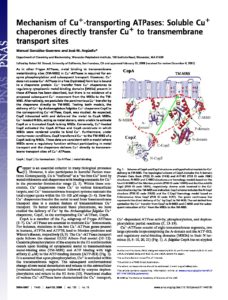
Mechanism of Cu+-transporting ATPases: Soluble Cu+ chaperones directly transfer Cu+ to transmembrane transport sites
Abstract
As in other P-type ATPases, metal binding to transmembrane metal-binding sites (TM-MBS) in Cu+-ATPases is required for enzyme phosphorylation and subsequent transport. However, Cu+ does not access Cu+-ATPases in a free (hydrated) form but is bound to a chaperone protein. Cu+ transfer from Cu+chaperones to regulatory cytoplasmic metal-binding domains (MBDs) present in these ATPases has been described, but there is no evidence of a proposed subsequent Cu+ movement from the MBDs to the TM-MBS. Alternatively, we postulate the parsimonious Cu+ transfer by the chaperone directly to TM-MBS. Testing both models, the delivery of Cu+ by Archaeoglobus fulgidus Cu+ chaperone CopZ to the corresponding Cu+-ATPase, CopA, was studied. As expected, CopZ interacted with and delivered the metal to CopA MBDs. Cu+-loaded MBDs, acting as metal donors, were unable to activate CopA or a truncated CopA lacking MBDs. Conversely, Cu+-loaded CopZ activated the CopA ATPase and CopA constructs in which MBDs were rendered unable to bind Cu+. Furthermore, under nonturnover conditions, CopZ transferred Cu+ to the TM-MBS of a CopA lacking MBDs. These data are consistent with a model where MBDs serve a regulatory function without participating in metal transport and the chaperone delivers Cu+directly to transmembrane transport sites of Cu+-ATPases.z

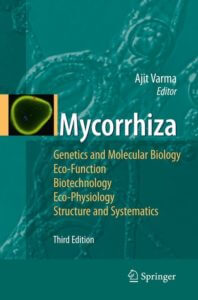
In vitro cultures: open new prospects for basic research in arbuscular mycorrhizas
Abstract
Mycorrhizas are symbioses between fungi and the roots of higher plants. As more than 90% of all known species of plants have the potential to form mycorrhizal associations, the productivity and species composition and the diversity of natural ecosystems are frequently dependent upon the presence and activity of mycorrhizas. The biotechnological application of mycorrhizas is expected to promote the production of food while maintaining ecologically and economically sustainable production systems.
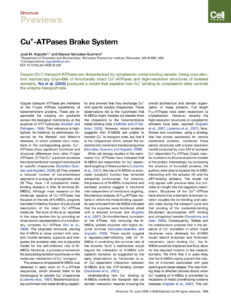
Abstract
Copper (Cu+) transport ATPases are characterized by cytoplasmic metal-binding repeats. Using cryo-electron microscopy (cryo-EM) of functionally intact Cu+-ATPases and high-resolution structures of isolated domains, Wu et al. (2008) produced a model that explains how Cu+ binding to cytoplasmic sites controls the enzyme transport rate.

The structure and function of heavy metal transport P1B-ATPases
Abstract
P1B-type ATPases transport heavy metals (Cu+, Cu2+, Zn2+, Co2+, Cd2+, Pb2+) across membranes. Present in most organisms, they are key elements for metal homeostasis. P1B-type ATPases contain 6-8 transmembrane fragments carrying signature sequences in segments flanking the large ATP binding cytoplasmic loop. These sequences made possible the differentiation of at least four P1B-ATPase subgroups with distinct metal selectivity: P1B-1: Cu+, P1B-2: Zn2+, P1B-3: Cu2+, P1B-4: Co2+. Mutagenesis of the invariant transmembrane Cys in H6, Asn and Tyr in H7 and Met and Ser in H8 of the Archaeoglobus fulgidus Cu+-ATPase has revealed that their side chains likely coordinate the metals during transport and constitute a central unique component of these enzymes. The structure of various cytoplasmic domains has been solved. The overall structure of those involved in enzyme phosphorylation (P-domain), nucleotide binding (N-domain) and energy transduction (A-domain), appears similar to those described for the SERCA Ca2+-ATPase. However, they show different features likely associated with singular functions of these proteins. Many P1B-type ATPases, but not all of them, also contain a diverse arrangement of cytoplasmic metal binding domains (MBDs). In spite of their structural differences, all N- and C-terminal MBDs appear to control the enzyme turnover rate without affecting metal binding to transmembrane transport sites. In addition, eukaryotic Cu+-ATPases have multiple N-MBD regions that participate in the metal dependent targeting and localization of these proteins. The current knowledge of structure-function relationships among the different P1B-ATPases allows for a description of selectivity, regulation and transport mechanisms. Moreover, it provides a framework to understand mutations in human Cu+-ATPases (ATP7A and ATP7B) that lead to Menkes and Wilson diseases.
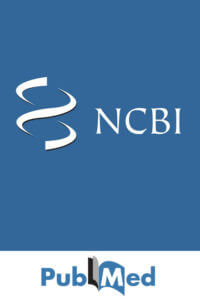
Novel Zn2+ coordination by the regulatory N-terminus metal binding domain of Arabidopsis thaliana Zn2+-ATPase HMA2
Abstract
Arabidopsis thaliana HMA2 is a Zn2+ transporting P1B-type ATPase required for maintaining plant metal homeostasis. HMA2 and all eukaryote Zn2+-ATPases have unique conserved N- and C-terminal sequences that differentiate them from other P1B-type ATPases. Homology modeling and structural comparison by circular dichroism indicate that the 75 amino acid long HMA2 N-terminus shares the betaalphabetabetaalpha folding present in most P1B-type ATPase N-terminal metal binding domains (N-MBDs). However, the characteristic metal binding sequence CysXXCys is replaced by Cys17CysXXGlu21, a sequence present in all plant Zn2+-ATPases. The isolated HMA2 N-MBD fragment binds a single Zn2+ (Kd 0.18 microM), Cd2+ (Kd 0.27 microM), or, with less affinity, Cu+ (Kd 13 microM). Mutagenesis studies indicate that Cys17, Cys18, and Glu21 participate in Zn2+ and Cd2+ coordination, while Cys17 and Glu21, but not Cys18, are required for Cu+ binding. Interestingly, the Glu21Cys mutation that generates a CysCysXXCys site is unable to bind Zn2+ or Cd2+ but it binds Cu+ with affinity (Kd 1 microM) higher than wild type N-MBD. Truncated HMA2 lacking the N-MBD showed reduced ATPase activity without significant changes in metal binding to transmembrane metal binding sites. Likewise, ATPase activity of HMA2 carrying mutations Cys17Ala, Cys18Ala, and Glu21Ala/Cys was also reduced but showed a metal dependence similar to the wild type enzyme. These observations suggest that plant Zn2+-ATPase N-MBDs have a folding and function similar to Cu+-ATPase N-MBDs. However, the unique Zn2+ coordination via two thiols and a carboxyl group provides selective binding of the activating metals to these regulatory domains. Metal binding through these side chains, although found in different sequences, appears as a common feature of both bacterial and eukaryotic Zn2+-ATPase N-MBDs.

GintMT1 encodes a functional metallothionein in Glomus intraradices that responds to oxidative stress
Abstract
A full-length metallothionein (MT) gene (GintMT1) was isolated from Glomus intraradices extraradical mycelium. This is the first MT gene reported in the genus Glomus, third in the Glomeromycota. Functional analysis of GintMT1 in a MT-defective Saccharomyces cerevisiae strain indicates that it encodes a functional MT. Gene expression analyses revealed that the transcript levels of GintMT1 were elevated in mycelia treated with 5 mM Cu or paraquat but inhibited in mycelia treated with 50 μM Cu or 450 μM Cd. The elevated expression of GintMT1 in the 5 mM Cu-treated mycelia together with the ability of GintMT1 to provide tolerance to a Cu-sensitive yeast suggests that GintMT1 might afford protection against Cu. Induction of GintMT1 expression by paraquat and 5 mM Cu, treatments that also produced an oxidative damage to the fungal membranes, suggests that GintMT1 may play a role in the regulation of the redox status of the extraradical mycelium of G. intraradices.
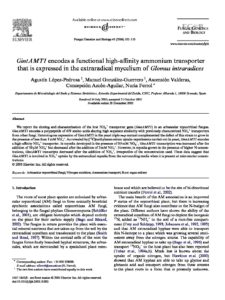
GintAMT1 encodes a functional high-affinity ammonium transporter that is expressed in the extraradical mycelium of Glomus intraradices
Abstract
We report the cloning and characterization of the first NH4+ transporter gene (GintAMT1) in an arbuscular mycorrhizal fungus. GintAMT1 encodes a polypeptide of 479 amino acids sharing high sequence similarity with previously characterized NH4+ transporters from other fungi. Heterologous expression of GintAMT1 in the yeast triple mep mutant complemented the defect of this strain to grow in the presence of less than 1 mM NH4+. As revealed by [14C]methylammonium uptake experiments carried out in yeast, GintAMT1 encodes a high-affinity NH4+ transporter. In mycelia developed in the presence of 0.9 mM NO3−, GintAMT1 transcription was increased after the addition of 30 μM NH4+ but decreased after the addition of 3 mM NH4+. However, in mycelia grown in the presence of higher N concentrations, GintAMT1 transcripts decreased after the addition of NH4+, irrespective of the concentration used. These data suggest that GintAMT1 is involved in NH4+ uptake by the extraradical mycelia from the surrounding media when it is present at micromolar concentrations.
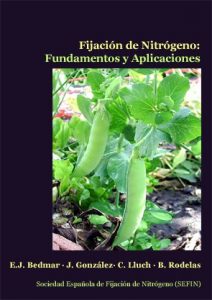
Establecimiento y función de las micorrizas arbusculares. In Fijación de Nitrógeno: Fundamentos y Aplicaciones
Abstract
Este libro aborda la fijación biológica del nitrógeno en vida libre y en simbiosis a través de las revisiones realizadas por los diferentes grupos de investigación que pertenecen a la SEFIN. Se ha estructurado en tres apartados diferenciados que recorren el proceso de fijación de nitrógeno en la biosfera, la interacción Rhizobium-leguminosa y la implicación ecológica y agronómica del proceso. En ellos se incluyen temas que describen la diversidad genómica y evolución de los endosimbiontes diazotrofos, la bioquímica y biología molecular de las enzimas implicadas, las señales e interacciónes entre microorganismos rizosféricos, el diálogo molecular entre simbiontes, el metabolismo carbonado, nitrogenado, oxidativo y hormonal del nódulo como órgano singular que se genera en la simbiosis. Además, se repasan las asociaciones endofíticas, actinorrícicas e incluso aquellas que se forman con hongos de la micorriza o con PGPRs, así como la producción de inoculantes bacterianos, fitorrecuperación de suelos y biodegradación, todos ellos implicados en Agricultura sostenible.
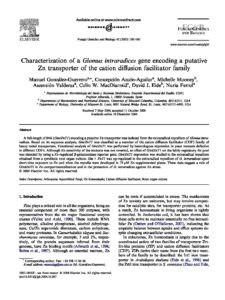
Characterization of a Glomus intraradices gene encoding a putative Zn transporter of the cation difusión facilitator family
Abstract
A full-length cDNA (GintZnT1) encoding a putative Zn transporter was isolated from the extraradical mycelium of Glomus intraradices. Based on its sequence analysis, GintZnT1 was classified as a member of the cation diffusion facilitator (CDF) family of heavy metal transporters. Functional analysis of GintZnT1 was performed by heterologous expression in yeast mutants defective in different CDFs. Although Zn sensitivity of the mutants was not reverted, an effect of GintZnT1 on the labile regulatory Zn pool was detected by using a Zn-regulated β-galactosidase reporter gene. GintZnT1 expression was studied in the extraradical mycelium obtained from a symbiotic root organ culture. Gin ± ZnT1 was up-regulated in the extraradical mycelium of G. intraradices upon short-time exposure to Zn and when the mycelia were developed in 75 μM Zn supplemented plates. These data suggest a role of GintZnT1 in Zn compartmentalization and in the protection of G. intraradices against Zn stress.
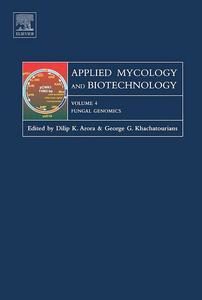
Genomics of arbuscular mycorrhizal fungi
Abstract
Arbuscular mycorrhizal fungi are soilborne microorganisms that form a mutualistic symbiotic association with most land plants. As obligate biotrophs these fungi are unable to complete their life cycle in the absence of the host plant. This symbiosis is increasingly being recognised as an integral and important part of natural ecosystems throughout the word. Because of the incalcitrance of arbuscular mycorrhizal fungi to grow in pure culture and consequently the difficulties in obtaining sufficiently large quantities of fungal material, the analysis of gene products has remained an extremely challenging but unexplored area. Until recently, little was known about the genomics of these fungi and it is only with the advent of powerful molecular techniques that it has been possible to venture research into their genetic makeup. This review surveys the most recent molecular genetics of arbuscular mycorrhizal fungi and their contributions to basic knowledge of the biology of this group of organisms.
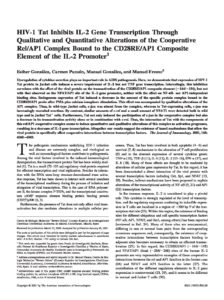
HIV-1 Tat inhibits IL-2 gene transcription through qualitative and quantitative alterations of the cooperative Rel/AP1 complex bound to the CD28RE/AP1 composite element of the IL-2 promoter
Abstract
Dysregulation of cytokine secretion plays an important role in AIDS pathogenesis. Here, we demonstrate that expression of HIV-1 Tat protein in Jurkat cells induces a severe impairment of IL-2 but not TNF gene transcription. Interestingly, this inhibition correlates with the effect of the viral protein on the transactivation of the CD28RE/AP1 composite element (−164/−154), but not with that observed on the NFAT/AP1 site of the IL-2 gene promoter, neither with the effect on NF-κB- nor AP1-independent binding sites. Endogenous expression of Tat induced a decrease in the amount of the specific protein complex bound to the CD28RE/AP1 probe after PMA plus calcium ionophore stimulation. This effect was accompanied by qualitative alterations of the AP1 complex. Thus, in wild-type Jurkat cells, c-jun was absent from the complex, whereas in Tat-expressing cells, c-jun was increasingly recruited overtime. By contrast, similar amounts of c-rel and a small amount of NFAT1 were detected both in wild type and in Jurkat Tat+ cells. Furthermore, Tat not only induced the participation of c-jun in the cooperative complex but also a decrease in its transactivation activity alone or in combination with c-rel. Thus, the interaction of Tat with the components of this rel/AP1 cooperative complex seems to induce quantitative and qualitative alterations of this complex as activation progresses, resulting in a decrease of IL-2 gene transcription. Altogether our results suggest the existence of tuned mechanisms that allow the viral protein to specifically affect cooperative interactions between transcription factors.
